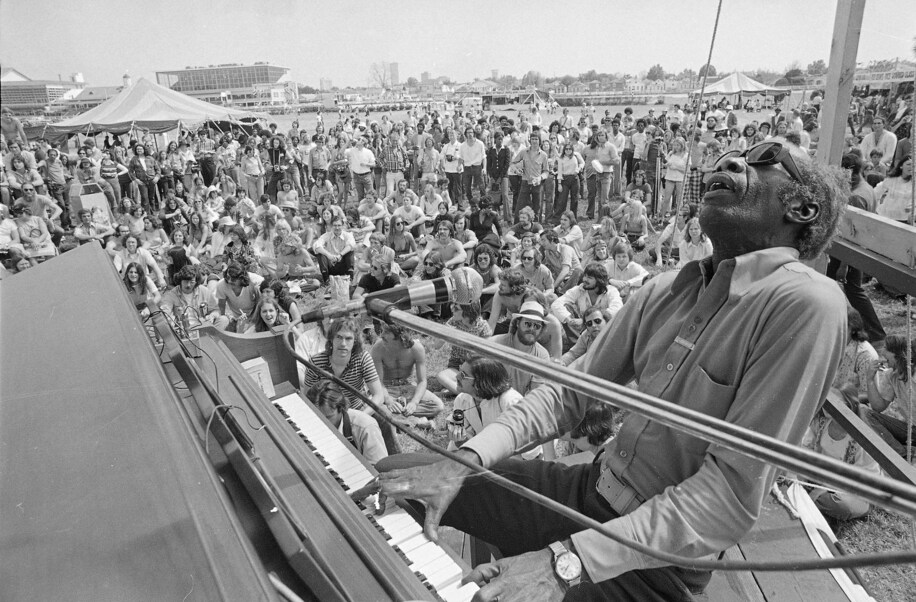Mardi Gras in New Orleans

My passion for New Orleans music ramped up to infatuation on July 3, 1973, when I heard Professor Longhair for the first time in Central Park. The experience still stands as the single greatest unanticipated musical discovery of my life. I knew nothing about Fess at the time and it’s unlikely I’d heard him on record. The bulk of the pianist’s recordings had been made two decades earlier and by the early 60’s he’d fallen into obscurity, spending the next decade working odd jobs and gambling. But his single, “Go to the Mardi Gras,” remained a seasonal favorite in the Crescent City, and in 1971 George Wein happened to hear it on the jukebox at what he recalled as a “little bar on Magazine Street.”
Impressed by the song’s blend of parade beats and rumba rhythms, Wein, who’d produced the first New Orleans Jazz & Heritage Festival the previous year, turned to his local scouts, Allison Miner, Quint Davis, and Dick Allen, to ask who he was listening to and if the artist was still alive. In his autobiography, Myself Among Others, Wein says that when he learned Fess was both alive and local, he exclaimed, “Don’t you guys realize this is what our festival is all about? Let’s find Professor Longhair and bring him back.”
Miner and Davis soon got an address for Fess, who was born Henry Roeland Byrd, and discovered him living an impoverished life “in a totally depreciated state physically…When he [stood] up, his knee would rattle around until it set into a groove so he could walk. He had a vitamin deficiency, he had no teeth, no digestion.” He was also starved for attention, and just a few weeks later he made a triumphant appearance at Jazz & Heritage. Here’s how Davis remembered it: “When he started playing—this sounds like a cliché—everything else stopped dead on the other stages. There were four acts playing simultaneously, and the crowd just gathered and gaped. They had never heard anything like him. It was a truly magic moment.”
Longhair’s performance generated such interest that an album of his classic Atlantic recordings of 1949 and ’53 was reissued before year’s end, and he began playing engagements outside of New Orleans. He started recording again, too. A year later, Wein presented him at the second annual Newport-in-New York Jazz Festival, and that’s where I saw him. But it wasn’t Fess who drew me to the concert that was billed as “An Afternoon of Jazz for Children and Adults.” In addition to groups led by Charles Mingus and Don Cherry, what attracted me to Wollman Rink was a quintet of tap dancers, including the legendary hoofers Baby Laurence, Buster Brown, and Chuck Green, who were dancing to the accompaniment of organist Milt Buckner and drummer Jo Jones. (For the record, Cherry’s group included Gato Barbieri and Charlie Haden; Mingus’s featured Bobby Jones and Jaki Byard; and Fran Allison, of Kukla, Fran, and Ollie fame, served as emcee.)
Fess led off the concert with a half dozen of his highly original piano blues. Whitney Balliett reported on it for The New Yorker, describing Fess as “semi-legendary,” and in the best sense of the word, “antediluvian…one of the last repositories of this sort of rolling, heavy-weave barrelhouse piano. It will be a sad day when [the style] is finally gone.” And gone too fast it was that afternoon. Notwithstanding an exciting show by the tap masters that proved to be a real treat for the scores of kids in attendance, all I could think about was the amazing singer-pianist whose thirty-minute set suddenly seemed like a distant memory. As it happened, it would be five years before I got to a second look at Fess when he played Jonathan Swift’s in Cambridge. If I had to do it all over again, I would have flown to New Orleans to see him with the locals. Fess died in 1980 at 62. In keeping with his semi-legendary status, he passed on the day that his final album, Crawfish Fiesta, was released on Alligator Records. He was elected to the Rock’n’Roll Hall of Fame in 1985.

Fess was back in the news recently with the dedication on February 21 of the home he’d purchased in 1979 at 1738-1740 Terpsichore Street. The first floor of the refurbished two-story will house a museum in his memory. How deliberate was it that Roy Byrd bought property on the street named for the Muse whose name signifies delight in dancing? The gangly Fess was a hoofer himself before the piano became his calling. As a teenager, he and a friend named Streamline Harris danced in the clubs on Rampart Street, and the intricate patterns they worked out eventually found their way into his keyboard style. If I’d known this 41 years ago, I would have been more observant of Fess during the set by the tap masters in the park. Did he sit down front and take it all in? One can imagine the delight he felt in sharing the bill with these old hoofers.